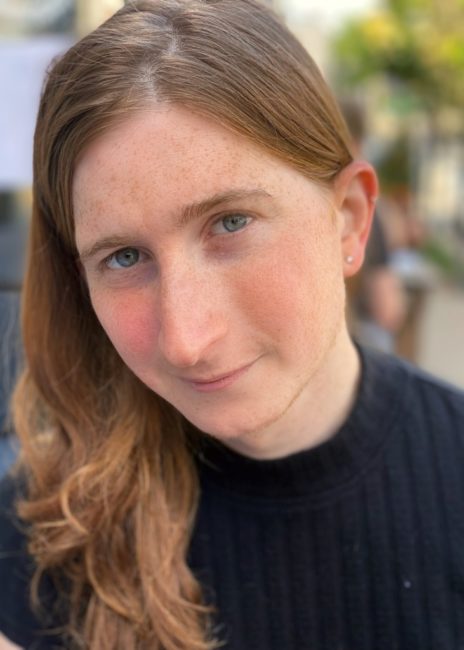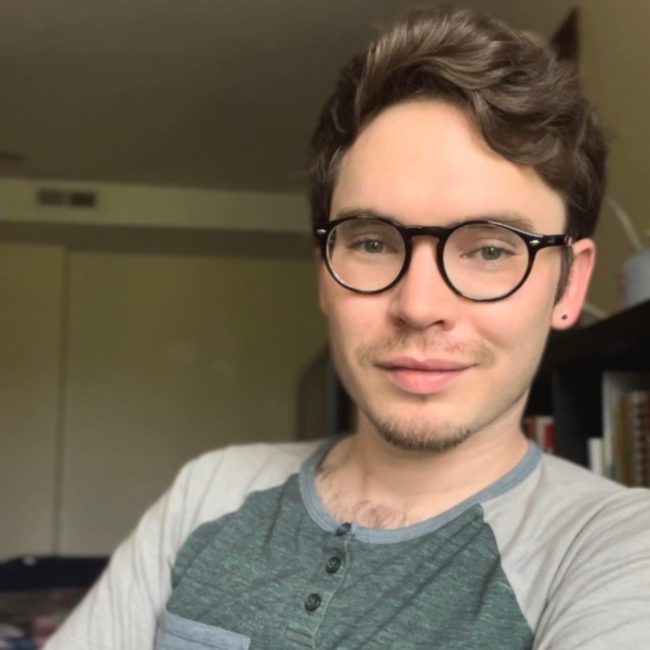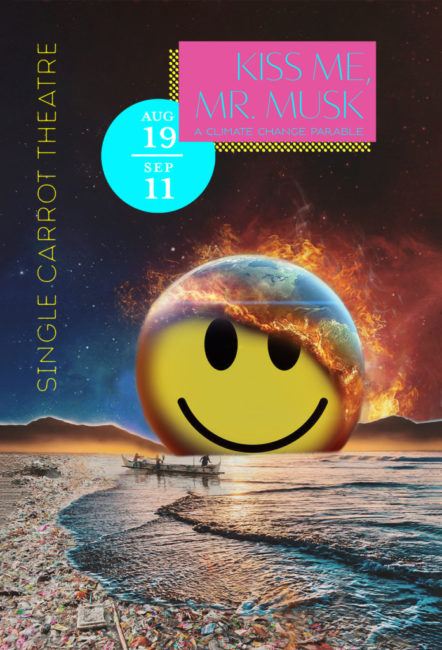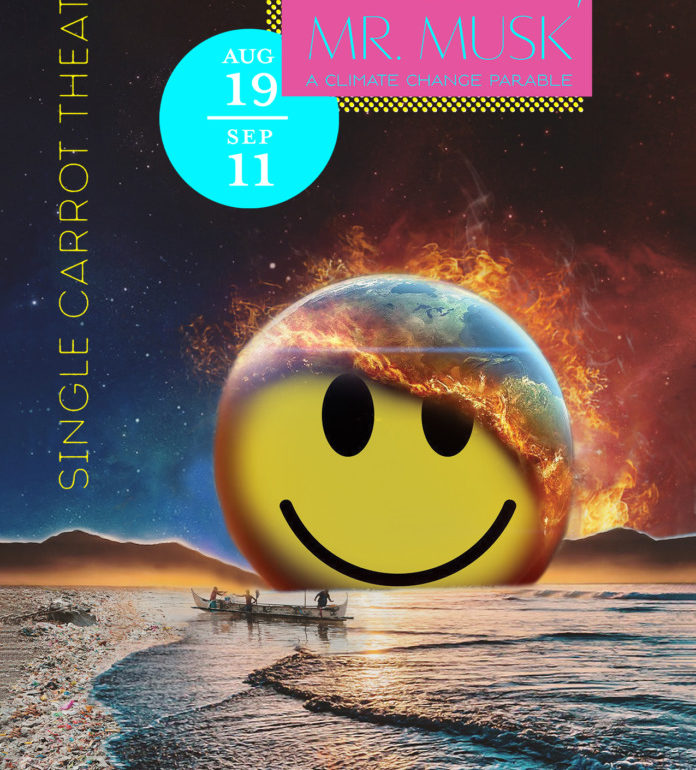You’re gonna need a bigger boat. No, it’s not Jaws: The Musical (but I’m sure that’s coming…just look at Back To The Future: The Musical headed to Broadway in spring of 2023)…but you are definitely going to need a bigger boat if sea levels rise and Baltimore City becomes flooded. Perhaps Papa Bezos will lend you his space-rocket or let you rent out his penthouse suite at the new Moon Hotel. On the moon. While all of that may sound fantastical— in the chimerically impossible sense, not the “ooh goody let’s go to the moon with Jeff Bezos and company sense— it doesn’t seem all that far-fetched, given the current state of affairs in the world, particularly when it comes to global warming and climate change. Single Carrot Theatre— proving their resiliency is more potent than ever— has not only survived the pandemic but is currently thriving and back to part of their integral operative in the Charm City DIY-theatre scene: they’re presenting a wholly new devised work. And this work tackles Climate Change. In a TheatreBloom interview, we’ve spoken with Director B Kleymeyer and Video Designer Kolton Cotton about the upcoming Season15 opener, Kiss Me, Mr. Musk.
Thank you both so very much for sitting down to chat with me today; I’m thrilled to get to hear about this endeavor. There has yet to be a show produced at Single Carrot Theatre that has not made me deeply contemplate everything from my own existence as a human to the state of the world and all that rests in-between. And I’m doubly thrilled to see that the company is returning to its devised works! At any rate, I’m so excited to have both of you here— can you give our readers a quick intro to who you are and what you’re doing with the project?

B Kleymeyer: My name is B Kleymeyer and my pronouns are she/her. I am a co-creator and director of the piece. I started developing Kiss Me, Mr. Musk with Single Carrot in 2019. It started from the idea of wanting to do a piece about climate change and then we did about two years of workshopping and developing that led us here to now being in production.
Kolton Cotton: I’m Kolton Cotton, he/him. I am the video media designer as well as co-creator for the production. Thankfully I was brought on, this is my first production with Single Carrot and it has been a fabulous devising process that I have been a part of since actors were introduced.
Tell me a little bit about this “Kiss Me, Mr. Musk.” I know, B, you just said that you had wanted to do a piece about climate change but where did this particular project stem from. Was it an epiphany of waking up one morning and saying “Aha! I want to do a piece on climate change?” or what?
B: I used to be a company member with Single Carrot. I have since left the company— because I’m now at Grad School. But when I was still a company member, we would— about once a month— get together and each of us would lead a training. We would train together every month and everyone would have a month to plan a training. Back in 2019 I was planning a training and I was thinking really deeply about climate change at the time. I don’t remember exactly what it was that was bringing those thoughts out but it was what I was most stuck on at the time. So I said, “Hey, here’s a seed of something, let’s just play.” And we started doing some compositional work around the concept of climate change. From there, we started talking specifically about the Chesapeake Bay. I think I was watching some videos of flooding in the Chesapeake Bay area; I became really obsessed with Tangier Island and what was happening there. I always hoped this would eventually become a piece, but it started as a way to just keep training together and keep our compositional skills intact and continue as a company, having a shared gestural language that we work from.
Afterwards, everyone really loved what came out of it. And I thought— “great! How about next month I’ll do another training. Between now and then, everyone make a solo piece about climate change.” We got back together a month later, the pandemic had happened, so now all of the sudden we were on Zoom. But everyone had made the loneliest and saddest compositions about climate change. Some people had made videos, some people had written scenes, there were just all sorts of things in response to these videos that I had sent out— videos of flooding— and these pieces were just so lonely and sad. And they were not focused on human life. Everyone was so focused on the objects in their house! That just cracked it open for us— it gave me that moment of “there’s something here, let’s keep exploring. Let’s talk about climate change but not from the perspective of people. Let’s keep playing with this idea of what is around our house; what do we see? What are going to leave behind?”
Then we had this central question— What do we leave behind? Climate disaster is happening; what are we going to leave behind? From there we started workshopping more and we started having meetings with some scientists in the area. We started learning more about climate change in the Chesapeake Bay and then we decided to turn it into a production. Then we brought Kolton on because very early on in the process video became very important. Firstly because we were still on Zoom, and while we knew the piece wasn’t going to be on Zoom there was something about working on Zoom that was just so fascinating. I was actually thinking about this earlier today— one of the earliest compositions of the piece was someone holding a glass of water up to their Zoom camera. That image is so present in the final rendition of the piece. The idea of media and scale— because objects are so little— became very important. Kolton is a close collaborator of mine so I brought Kolton on to continue creating.

Kolton, you’ve said you’re doing video and media design for this production, what has it been like from your perspective to come in and collaborate and build this project?
Kolton: I think B said the key word, which was play. I think whenever you’re in a rehearsal room, having someone that is willing to just make weird choices— whether that’s putting a flashlight up to a fish tank and throwing paper and doll parts in it— you just kind of see what is working and what isn’t working, and having that ability to have that communication and flow of just allowing something to happen so that you can then take a step back and see ‘is this something that is moving us?’ I think is just a really beautiful and healthy way of working. It’s been great. I think what’s been really important for B and I has been having the work be really actor focused, so that it’s not just a bombardment of images. So the actors are actually moving cameras and creating the imagery that we’re seeing. You have a lot of these double events happening which gives you the opportunity to look at the focus of the story itself or the ensemble of actors creating this world in front of you. It’s very much a theatrical thing that I’m really excited that we can include in this work.
Where did the title Kiss Me, Mr. Musk come from? While that seems wholly on brand for a Single Carrot Theatre production, I feel like there must be a backstory there.
B: Single Carrot has a habit, whenever we’re creating a piece, of coming up with a title collaboratively. A lot of our titles come from these crazy brainstorms. This has happened a few times when we arrive at a block— or we’ve reached a wall in a devising workshop. And we say, “You know what? Let’s pivot. Let’s talk about a title.” And it’s way too early to talk about it so naturally, we do it! And we come up with the longest list of the craziest titles of all time and inevitably something comes out of that list that we find really exciting. And it ends up driving us in a direction.
The day we were doing this we had just had a conversation about billionaires. We had never mentioned them yet in our process of thinking about climate change because we were so wrapped up in the objects and what we leave behind. Then someone talked about billionaires. And there was this moment of “wow, that is this whole other world of climate change we haven’t talked about yet.” We just spiraled from there. The idea of these mysterious, God-like figures— like Elon Musk— who are actually in control of this climate crisis became this central idea for us. We were so interested in scale. We would go from the tiniest thing— like a bag of chips— to the biggest thing, which is Elon Musk. And really playing with the scale of these two things next to each other is really exciting to me.
It was really important and apparent that at every moment of this show, it is a comedy. This is fun. So the cheeky title helped us achieve that and helped to guide us because we can’t get stuck in how depressing climate change is. It has to also live in a place of play. There’s a whole other layer of it where we are very interested in deconstructing theatricality, which is a little bit of what Kolton was getting into, and that’s a lot of what we’re doing with the video cameras. It’s very much showing and then breaking down the ideas of theatricality. So we have this big, boisterous Broadway musical number at the top of the show called, “Kiss Me, Mr. Musk”—
I’m sorry— did you just say— there’s a musical number?
B: Oh yeah! Yeah, yeah, this is a musical. We have more than one musical number. This work is totally a musical. There’s music, there’s dancing, there’s puppets, there’s shadow puppets— we’ve got it all!
So in reading the synopsis and now in listening to you talk, I was getting the notion that there wasn’t a whole lot of ‘humans’ as we know them, happening as humans in this show, so I was wondering if there would be some use of puppets. And are there actual human characters but maybe they take a back seat or they’re floating in the periphery— tell me a little bit about that, without revealing any major show spoilers.
B: Humans do exist in this world. Elon Musk exists in this world. Right from the title we know that there are humans so that’s not a spoiler. But there are puppets— and every type of puppet! We have hand puppets, shadow puppets, large-scale puppets, tiny-object puppets— we have every type of puppetry you can think of, other than marionettes. We don’t have a marionette puppet yet. But pretty much everything else we’ve got going on.
I love that you’ve just said “yet. You don’t have marionettes yet.” Like somehow you could possibly get marionettes into the production before you open.
B: Oh for sure! That could totally happen. I mean we’re making puppets every day. This piece is about collage. It is a collage. At every moment we’re thinking about a new theatrical device to show. That’s why there are so many types of puppets. We just keep making and making and making and destroying and destroying and destroying, just like the process of consumption that has led us to where we are on this planet with climate change.

There is my next question for you. Because there is such a focus on climate change but the work has to live in a place of play, what is your sustainability for all of these puppets that you’re making and how does that align with views that you and the company might have on climate change?
B: For one— everything is made out of trash. Everything has already been used by our cast, our production team, or members of the Single Carrot family have been donating trash. We’ve been collecting things for a long time. The design team and production team are figuring out ways to reuse materials so that at the end of the show we can make sure we’re being responsible and recycling. They’re focusing on a lot of materials that are not being recycled properly beforehand too. That’s a huge part of the sustainability of it.
Kolton: We’ve got a community engagement component with that too.
B: There was a “seed-creation” of planting trees that we hosted as an event beforehand. We’re going to host some more during the run of the show as well. We partnered up with Blue Water Baltimore for that event and will be doing more of those types of things. Our set is made out of trash, our props are made out of trash, our costumes are made out of trash, everything is made out of repurposed material.
What has been your biggest challenge in the process so far for getting Kiss Me, Mr. Musk up on its feet?
B: Not living in complete climate despair. I very easily go to that place of despair about the state of the world. Finding joy and hope in the work has been the hardest part. But I have been.
Kolton: B and I had met in Pittsburgh and this is my first time visiting Baltimore. So I’ve been approaching this whole thing about Baltimore from an outsider’s perspective. I’ve been really trying to understand the audience and what it means to localize it. It’s been really interesting to learn about Mr. Trash Wheel (read more about the family of four— including the original Mr. Trash Wheel, Professor Trash Wheel, Captain Trash Wheel, and Gwynnda The Good Wheel of the West here on the ‘Meet The Family’ page.) There is a lot of history and myth— the legends of creatures deep in the Chesapeake Bay, like Chessie the Chesapeake Bay Monster— and it’s been really fun trying to get acquainted with that. I know there is this global sense of climate change but really, we’re right here in the back yard, and what can I do to make it about Baltimore? So I’ve really enjoyed going deep into the history of Baltimore and its infrastructure and learning all about that. I discovered there’s a tax on plastic bags and I see why being close to the water something like that incentivizes such programs. It’s little discoveries like that I have found challenging but has helped keep this project engaging for me.
B: I also think its really exciting having you here, Kolton, as the only person involved with the project who has not lived for a long time in this city. Because it forces us to think about the way we actually talk about and take for granted the things we know about Baltimore and the Chesapeake Bay. It’s definitely made us slow down, like the conversation we had about the Trash Wheel because you didn’t even know it existed or what it was. That almost didn’t even make it into the show because we all don’t even think about it anymore, it’s just such an intrinsic and assumed part of Baltimore culture.
But it made it into the show, right? You cannot do a show about climate change in Baltimore without some mention of Mr. Trash Wheel & Family…
B: Oh for sure. There’s allusions to it.
It sounds like having the proverbial outsider in Kolton has been a really great experience for everyone involved because it sort of resets your perspective. That’s fantastic to hear! Do you two have a moment in the show that really defines what this experience means to you?
B: Yeah. I think the word I’ll give you is processional and miniature.
Kolton: Reflection, barrage, and distraction.
What has been your big personal takeaway for you both being involved with this devised work? What has it taught you about yourself?
B: Something I have been thinking about a lot more while I work on this show is generational divide and the way different generations feel about climate change and the way that we talk about climate change. We have a wide range of ages of performers. That has been really exciting to live in the middle of the span of ages that we’re working with. It makes me see how we have to work really hard to talk to each other about this.
Kolton: B and I have also been co-teaching a camp. So we spend all day together. We spend a lot of time with children. So we have, not only the actors of the production sharing their opinions with us, but when the kids at the camp ask us what we’re working on and we tell them we’re working on this show, we then get their opinions. To hear the insights of a 12-year-old is sometimes so profound that you’re just blown away. Like wow. It’s one thing to hear the word ‘climate change’ and you already have a feeling, you already have an association for hearing that. But whenever you hear it from the perception for a child, that response totally changes. It reframes it.
B: I totally get that and it definitely resonates for me. Some of our performers’ children have been in the room. Like five-year-old children— even the voices of our students have made it into the show. I’ve become really obsessed with the way that everyone has such a different and distinctive voice about climate change.

What is the one thing you would say to potential audience-goers that would entice them to come and see Kiss Me, Mr. Musk?
B: Puppets. I mean, if puppets doesn’t do it…then I don’t know why you’re in Baltimore!
Kolton: I think the time is appropriate. It is an 80-sprint of a collage. And there’s puppets and there’s music and there’s dancing. The costumes are made out of trash and they’re really beautiful. What more could you want?
Is there anything else you two wanted to say about the experience, about Trash Wheel, about Baltimore, Single Carrot, or Theatre Project?
B: Oh I am just so excited to be at Theatre Project! As a theatre artist in Baltimore I have such love for that space. To be able to bring this show that is so much about Baltimore to such a Baltimore institution is very, very exciting to me.
Kolton: I think we have captured it! Thank you so much for your time!
Thank you both so much! I wish you and Single Carrot Theatre all the best, lots of broken legs and big, full houses!
Kiss Me, Mr. Musk plays August 19, 2022 through September 11, 2022 with Single Carrot Theatre at Baltimore Theatre Project— 45 W. Preston Street in the Mt. Vernon district of Baltimore, MD. For tickets call the Theatre Project box office at 410-752-8558 or purchase them online.
To read Joshua Bermont’s review of Kiss Me, Mr. Musk: A Climate Change Parable click here.

